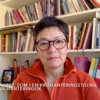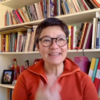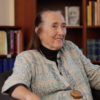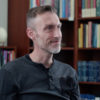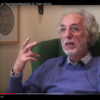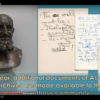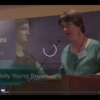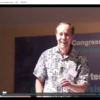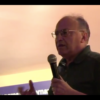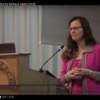This year, 2018, spring seems to be have been late everywhere and so it was in Fiesole on the day of the Equinox, March 21.
The wind was howling around the Piazza, as I made my way to a meeting with Piero Ferrucci, psychologist, philosopher, psychosynthesis psychotherapist and author of books like “What we may be”, “Beauty and the Soul”, “Inevitable Grace”, “Your Inner Will” and “The power of Kindness”, the latter which has recently been updated with a new chapter and re-published.
Climbing the narrow stairs to his top-floor studio, I thought of the joy his books have given me over the years and must admit to feeling a little star-struck as he greeted me with a warm handshake and showed me to his studio.
All the questions I had so diligently prepared, suddenly seemed irrelevant and I forgot them in my notebook as we started talking about the evolution of Psychosynthesis; past, present and future.
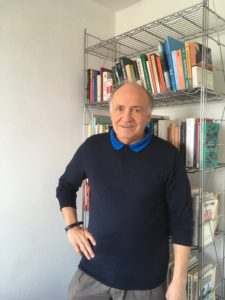
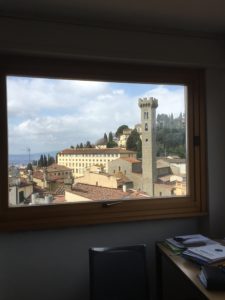
Where does Psychosynthesis stand today do you think?
Psychosynthesis is as alive and vibrant as ever; although there are so many things to choose from today that did not exist, say 30 years ago.
Psychosynthesis has a timeless quality. That is why it will always be modern.
The high-quality work done in many countries by the different training institutes and by therapists and other practitioners will ensure that Psychosynthesis continues to be a vibrant part of the world of psychotherapy and of individual development, for people who want to express their own uniqueness and realize their potential.
In your view, how can we make Psychosynthesis better known?
Number one is to publish! Publish books, articles, writings. That goes around and it reaches people. And it should be books that are reader-friendly without being superficial. Some people are talented in writing. I don’t consider myself talented; I had to learn how to write.
If you call me a storyteller and I tell stories, it is because people like stories. I can see their faces change as I tell stories in a lecture.
If you think my books flow like stories, I still tell you it is a skill you can learn. One of the things I analyse about my writing is the continuity. There should be a flow from one paragraph to the other in writing, there should be continuity in the text. Often we write in a zick-zack and then we have to create the flow.
Number two is the quality of work. Don’t give up the quality of work! That will withstand all trends and be there as a guarantor for Psychosyntesis.
Number three is harmlessness. And by that I mean that if we are kind and abstain from criticism and pettiness and have good relationship among the people in a group, that group becomes much more powerful. I am convinced of that. Also healthier, because harmfulness and saying bad things about others is harmful to our health so it’s a stop in the flow of good vibrations. And so I think a group that is harmless can go a very long way and I don’t see that happening yet enough in Psychosynthesis in general.
The power of kindness goes a long way. What the Dalai Lama says about kindness is that “kindness is wanting other people’s good and that compassion is wanting them not to suffer”. These are really about the same thing. Compassion maybe sounds better. It has passion as well.
Number four is public work like lectures. I think lectures have a good effect because they are not too committal. People can go for an evening and that’s it. You can sit there and not really be too involved, but you can have a look at the person giving the lecture and maybe you like that person or you simply read the brochure. But if that person is really warm and nice and funny, then it is more likely that you go and follow a course by that person. So, lectures and presentations have quite a lot to offer Psychosynthesis.
I know you have a special place in your heart for Art and Beauty. How does those areas come into therapy do you think?
What you said before that culture is part of our work, I fully agree. It is as useful for people learning how to be a therapist to read Kafka and Tolstoy and similar classics. You can learn a lot about human nature through fiction, so it is important to read good fiction as well as psych-culture books. There is often a lot of knowledge of human nature in great art, including portraits, great paintings.
How can we reach young people with the offer of psychosynthesis?
That is a hard question, maybe I should think more of age. I tend to think of people as Selves, as souls, timeless. And so young people can be just as good and wise as old people and vice-versa.
You mentioned midlife crisis but when is the midlife crisis? Adolescence ends around 25 years old. And in principle what would attract younger people could be the same that would attract older people. There may be things more attractive to younger people, but I don’t know. I have not been good at attracting younger people. Many of the people who come to my lectures are young psychologists, are people in their 30s or 40s, people who have gone through part of their lives. Often there are some difficulties and traumas in the second part of your 20’s and those are the formative years. And then people start thinking more of existence and the meaning of their existence.
Many young people don’t know what they want to do. They don’t know what their call is. They go from one thing to the other and they just think that they want to earn a lot of money, but don’t know how. They think in terms of where can I make money, where can I find jobs, that kind of thinking. Helping young people find their call is important, because often they don’t even think in those terms.
Often, even when they start university they don’t know what to do. They switch from one area to the other and they just follow phantasies. They are not well informed. There are always new jobs and careers created that we don’t know anything about. We can just think in terms of old categories of jobs like doctors, lawyers, bankers, but there are many new fields. We need to show the more intrinsic ways of thinking than the extrinsic.
There has to be a bridge between working individually with a person and also helping them to find out what their call is… what their dream is. Sometimes that appears in childhood and then disappears. Bridging the dream or the calling with the real world, could be helpful to many people.
What risks do you see to the field of Psychosyntesis today?
The greatest risk is always the same, that of doing bad work. By that I mean doing bad sessions, giving out bad teaching. Also being harmful in the sense of saying bad things about others, about colleagues.
The remedy is just doing, just trying to do our best work and supervise it. We all make a lot of mistakes, which is ok but we have to learn from our mistake. The quality is always an important issue.
It is a big responsibility to guide people to do the inner work. As I always say when I teach, we often have to improvise because if we didn’t, that would be another risk. People adopting a method, step 1, step 2, step 3 and just applying it to everybody that would be dreadful. The truth is that we improvise because every person that comes to us is unique, is different, so I don’t like classification and diagnoses, although it has to be done but always look for the uniqueness… official diagnoses tells you everything about an individual except the essential.
We have to look at the essentials about that person and that person’s world, rather than having them come to our world, our worlds, our terms or our view of the world. And for that reason we have to start all over again with every new client.
What do you see as the potential for the future of Psychosynthesis?
We have barely scratched the surface of that yet. Because the potential is having a society where people work on themselves.
And we are on our way to that because when I was a child or teenager we didn’t have gyms and people didn’t go to the gym to have a workout. If you saw someone running in the street you thought there was a fire or an emergency. And now everybody do workouts in gyms and in other places. It is an industry and it is part of the culture. We live in an era of distraction, where there is always too much stimuli to deal with.
That being part of our culture, including Psychosynthesis culture, means we have to make room for work on ourselves. The future, in my opinion, is people working out, not only physically, but also mentally and spiritually.
We have to make room for work on our selves. The habit of meditation is sometimes forgotten even among Psychosynthesis people, of whom many do not meditate regularly. When it is no longer a habit, the kind of lives we lead will be distracting from it. Meditation can create a very big change in our culture. Nowadays the most popular meditation is mindfulness, which belongs to a very noble and beautiful tradition which is often unfortunately lost, and meditation is presented as a way to deal with stress, which is belittling, so it is transformed into almost a physical or psycho-physical discipline you can do it at the gym. You close your eyes, you relax, you hear nice music and that’s called meditation, but meditation is so much more than that. For the future, I would envisage more mental and spiritual work and I would also envisage a more conscious cultivation of beauty.
There has never been so much potential for beauty as now and yet people are in such a superficial frame of mind that they forget to enjoy beauty. I think we suffer from a deficit of beauty, which is comparable to a vitamin-deficit. Deficit endangers us and creates problems like depression or aggression or anxiety. People need beauty but they don’t realise it. It is like many old people, who become less conscious of being thirsty and so they put their body at risk. They are not aware of being thirsty. Their body is thirsty but they are not aware of this, so they forget about drinking.
It’s the same with beauty. Beauty is, I think, a biological need. Many animals realise the need for beauty too, it is part of our biology. If we don’t respect and fulfil that need, we are in trouble. There is a lot of ugliness around, and that is transforming our cities. Here, for instance what is happening to the Florence station is … I can see there is a war between beauty and ugliness and for the moment, ugliness is winning.
Beauty inspires life…
Thank you Piero Ferrucci! As I looked out through the window of your studio towards the silhouette of Fiesole and the hills towards Florence, I indeed saw beauty. I also felt the kindness you had shown me in giving me so much of your time. I felt my spirit soaring with joy. Connecting with you and with the roots of Psychosynthesis gives me great hope for the future. Thank you!
Ann Marie Lamb
Director PsykosyntesAkademin
Stockholm




